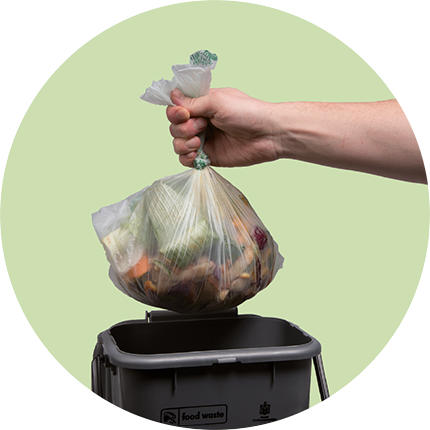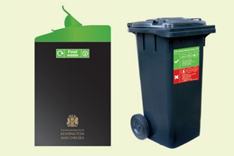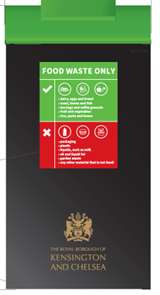Food waste collections
Overview
Helping you go greener
As part of our Council Plan and our commitment to making Kensington and Chelsea a Greener, Safer and Fairer borough, we are expanding the Food Waste Collection Service.
We collect food waste from:
- some kerbside properties – collected from outdoor food waste bins
- some estates and blocks of flats – collected from communal bins
- on-street food waste bins – collected from communal bins located at some of our mini recycling centres
Apply for food waste collections
To sign up for food waste collections, you will need to apply using one of the options below. If you are not sure what type of collection you require, see further information under ‘How to use the Service’.
Kerbside collections
We do not currently offer food waste collections across all of the borough. Before applying, please check if we are currently collecting from your street using the collection day checker.
If your street is listed, you can apply for collections.
Estates and blocks of flats
We have been working with landlords, housing providers and property managers to introduce communal food waste bins.
If your block does not currently offer food waste recycling please ask your property manager or site staff to get in touch with us:
- telephone: 020 7361 3001
- email: [email protected]
On-street food waste bins
If your property is near an on-street food waste bin, you can sign up to receive a 7-litre food waste kitchen caddy and caddy liners.
You can check your nearest on-street food waste bin by checking the mini recycling centre interactive map:
How to use the service

Kerbside collections
After you have signed up we will send you:
- a small, black, 7-litre kitchen food waste caddy
- a larger, black, 23-litre outdoor food waste caddy
- 12 months' supply of food waste liners
If your property is divided into multiple flats and you have a limited amount of space at the front of your property, you may need to share your outdoor caddy with your neighbours.
When your indoor food waste caddy is full, put your securely tied food waste liners into your outdoor food waste caddy and lock it by placing the handle forward.
Estates and blocks of flats
When your indoor caddy is full, put your securely tied food waste liners into the large communal food waste bin.


On-street food waste bins
Our on-street food waste bins are located at five of our mini recycling centres
What can go in your food waste caddy
Items you can put in your food caddy:
- raw and cooked food (including vegetables, meat, fish and bones)
- fruit and peelings
- dairy, including cheese and eggs
- bread and pastries
- tea bags and coffee grounds
- eggshells
- rice, pasta and beans
Please do not put these in your food waste caddy:
- packaging of any kind
- black bags
- garden waste
- liquids, such as milk
- oil or liquid fat
- any material that is not food waste
Order bins and liners
If you run out of liners, you can buy your own from supermarkets or other retailers. Our preference is that you use compostable bin liners.
Please do not use black or opaque bags as the crews will not collect them because they need to be able to check that only food waste is inside.
Alternatively, you can order extra liners from us using our online form.
Before you start, you will need:
- request type
- location
- evidence (optional)
- your contact details
Collection days
Your outdoor caddy should be at the front of your property by 7am on your collection day.
The crew needs to be able to spot your outdoor caddy from their vehicle on the road. Please make sure your caddy is placed:
- out by 7am on your collection day
- kerbside level
- at the edge of your property
- as close to the pavement as possible
Please do not put your outdoor caddy:
- on pavement
- in basements
- inside passages
- inside bin housing structures
Frequently asked questions
- Why is my property not being offered the new service?
-
We cannot currently offer a food waste collection for households with a lack of space to store and leave a caddy or bin for collection. We also only have two collection vehicles, meaning we are unable to offer food waste collections to all households even if they have sufficient storage space.
We are in the process of planning the introduction of a boroughwide service so that we are ready when the government announces funding to help councils roll out food waste, as announced in the Environment Act 2021.
- Why did we introduce the food waste recycling service?
-
Around 30% of our general waste is food waste. By taking part you will reduce the amount of general waste we collect and improve the borough’s environmental sustainability.
- Where does the food waste go?
-
The food waste collected is taken to an anaerobic digestion plant where it is used to generate electricity to power the national grid, and as a bio-fertiliser to grow crops. By using the bins for your leftovers, you are contributing to our ambition to be a carbon-neutral Council by 2030.
- How can I reduce my food waste?
-
We encourage our residents to reduce waste where possible, visit the Love Food Hate Waste website for tips and recipes on how to reduce your food waste and make delicious recipes using leftovers.
- What if I do not produce any food waste?
-
Remember there is no amount too small. The best thing we can do with our food is to enjoy it; but some waste like banana skins, tea bags and plate scrapings are inevitable. These can all be recycled.
- I do not have space for the caddy, what should I do?
-
The kitchen caddy is only 7-litre capacity and is designed to be kept on a kitchen work surface or under the sink. You can use your own container if you prefer something more stylish or it fits better in your kitchen.
- I do not have time to do this – why should I?
-
It is important we all contribute to increasing our recycling rates and reducing the amount of waste we incinerate. Recycled food waste can be turned into electricity for homes and fertiliser for farmers. Besides, it is really easy; all you need to do is follow the instructions on this webpage.
- Will the food in my bin smell?
-
No, food waste is collected weekly so it will not smell. Do not forget to empty your kitchen caddy regularly into the outside food bin and tie your liners. By recycling your food waste, you will take the smelliest content out of your waste, which will reduce bad odours in your general waste bin.
- Will you collect unwanted caddies?
-
If you have been given a food waste caddy but do not want it, please let us know, so we can collect it for reuse. You can email us at [email protected] or telephone 020 7361 3001.
Last updated: 6 August 2025
